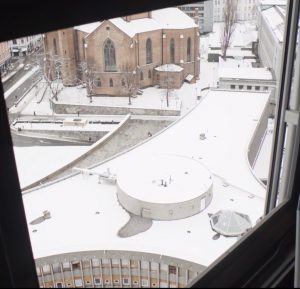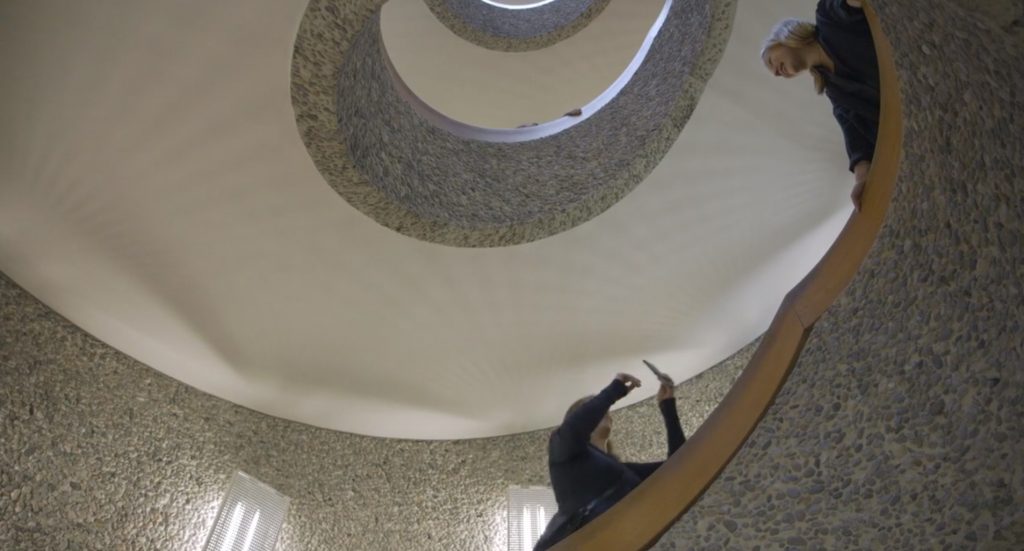(THIS ARTICLE IS MACHINE TRANSLATED by Google from Norwegian)
An eye-catching modernist building, created in the post-war era with striking forms cast in concrete. In the film we see how it is brutally torn down. Y-block in the government quarter in Oslo? No, other modernist buildings in Belgrade, Berlin and Bulgaria in the same architectural style that are as exposed as the Y-block. For many people around the world, brutalist-style buildings are "ugly" and incomprehensible. It is thought-provoking to see other iconic World Heritage buildings in the same fatal situation as the Y-block.
Vulnerable buildings
Buildings are weakened by weather, wind and use, but what really makes them vulnerable is that they are so closely tied to utility, to human needs. Thus, they are also subject to fluctuations in taste and by changing ideological winds.
Cato Fossum, Coordinator for short Film Festival, hits precisely in its introduction to the new program section "Architecture in Film": This year, not only the festival is digital, but also active in the social debate by contextualizing the fate of the Y-block. The two-hour program (in two parts) is based on the ongoing conflict around the Y-block, and is initiated and ended by two films that each deal with the block; Hammersborg – Protecting the Bygone Future by Birgitte Sigmundstad and drunk by Paul Tunge.

Never thought the block would be demolished
Paul Tunge describes how he filmed on an empty floor in the high block, that he lowered the camera and made a point towards the snow-covered Y block far down there. Together with his regular partner Egil Håskjold Larsen he was in the process of Bauta – part two of his architectural triology.
"I never thought the Y-block would be torn down, I had insisted on going in and filming the interiors."

"I never thought the Y-block would be torn down, I had insisted on going in and filming the interiors." Tongue lets the words hang a little in the air. The mobile conversation has taken a confidential turn. He talks about how in his everyday life he made sure to pass the Y-block and constantly find new details in the decoration or the building itself – it made him happy and excited.
He then captures too well the experience that can best be compared by constantly visiting a known and dear friend and the quality of life these small encounters and moments bring.
Now we both know that the days are spoken for Y.
Mourning hymns over a lost time
Both Tunges and Sigmunstad's films draw you into the architecture and the experience of the room, their ability to reproduce the tactile presence. Both films give relief to the fact that the demolition stopped voted down in the Storting last week – with 79 against 8 votes.
The inevitable day draws near Pablo Picasso's and Carl Nesjar's integrated gable wall mural The fishermen cut off. Then follows the removal of the interior mural Seagull and then demolition of the building itself. A building that was designed to stand for 2000 years is crushed to gravel.

Tunges and Håskjold Larsen's film drunk is almost devilish in its approach to a sober group of selected Norwegian modernist buildings. The Y-block is combined with power stations, metro stations and public pools.
Fossum's words about needs and the value of utility functionality over other qualities echo through the bare concrete cathedrals listed for everyday use. Tongue mentions he would highlight the forgotten buildings. Now both his and Sigmunstad's films have become documentation, mourning hymns over a lost time.
The various meanings of the Y-block – and the many aspects associated with the demolition case – emerge powerfully through historian Kjetil Jacobsen's essay in Sigmunstad's film. The text is performed in a strict and strong manner in English by playwright and performance artist Kate Pendry. The film is still as relevant as when it premiered a few years ago, and it has become a staple on the biggest social media sites for protecting and promoting the Y-block.

60 protest votes were not heard
The fight against the demolition of the Y-block has been going on for a long time, and almost 60.000 have signed during a protest. The most eager activists are now sleeping in tents in the square outside the former government building.
Is it a sign of the times that brutalism and modernism, the architecture of the Y-block, are seen as old-fashioned? Ugly?
MoMA, the Picasso Museum in Barcelona, Europa Nostra as well as international and national experts have required conservation. Even the City Council of Oslo has turned and gone in for preservation. Nevertheless, government and parliament do not let themselves go.
Bit by bit, signal buildings and world heritage are cut to pieces. Coordinator Fossum's text is eloquent when he asks: "Is it a sign in time that brutalism and modernism, the architecture of the Y-block, are expressed as old-fashioned? Ugly? A little functional? If so, what is that a sign of? "

Y-block and stave churches
Birgitte Sigmunstad was to make part of a documentary for CPH Dox and was looking for the Norwegian when she ended up on an open day in the government quarter and saw both the Y-block and the high-block. Immediately she called her photographer Line Lyngstadaas. They followed the screenings several times and chose to include the other participants in several of the film sequences.
The sacred effect of the Y-block's interiors is captured in their reactions in the face of the unique monumental conch staircase, the sand-blasted reliefs and the river gravel embedded in the concrete walls surrounding the round elevator shaft.

Jacobsen's text not only tells of the Y-block's tragedy, but sets up the structure against the previous 100 stave churches of which there are now only 28 remaining. Not even all these more intriguing decorative and declared memorable buildings were considered worthy of preservation.
In his essay, Jacobsen explains how the signal building Y – as a representative of the height of social democracy – had already played its role before the bomb collapsed. This idea puts the conservation struggle in a new relief. It is not about the individual building, it is about preserving the implicit social values that the buildings hold.
The films are shown below short Film Festival 10-14. June


